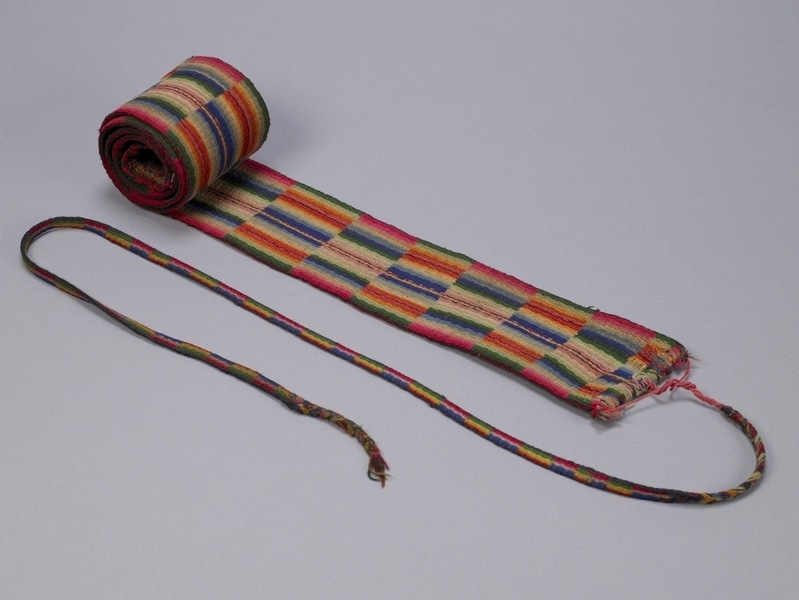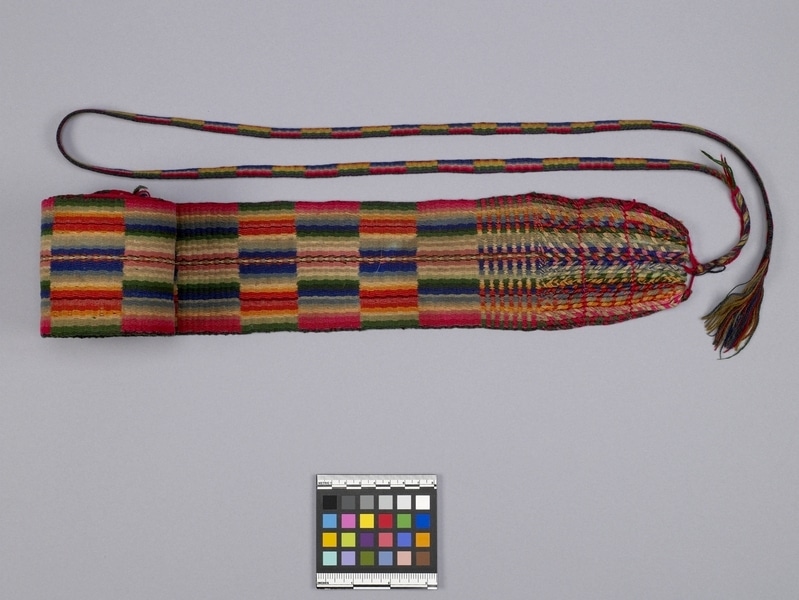Belt Item Number: Sf1011 from the MOA: University of British Columbia


Description
Belt with a pattern formed by a series of graduated hues ranging from light to dark and including the entire colour spectrum. Two separate colour series alternate in blocks. A single chevron band in orange, green, grey and white runs lengthwise along the centre of the belt. One end is finished with a fringe of 28 braids. Attached to both ends by red cords are narrow bands with a repeating pattern similar to the main belt.
History Of Use
Warp-faced fabric with three or four selvedges are woven by women but the fabrics are used by both sexes. The techniques, structures and some of the motifs have pre-Conquest antecedents. This type of textile conveys the most information about an individual's ethnicity, sex, age, status and particular history. Women on Taquile wear a thick, striped belt with chevron patterns for everyday wear. This belt is similar in these respects but it has a different weave structure than the more common belts. It also has a markedly different colour effect which arises from the double-faced structure. Women wear thick belts particularly during and after pregnancy. During pregnancy, they are worn tightly to keep the baby from growing too large, and thus preventing a difficult birth. The belts are also used to swaddle infants.
Narrative
Bought from Florentina Huatta Huatta who said that her grandmother Ursula Yucra, also of Taquile, made and used the belt. The belt is made in an unusual technique and Florentina had painstakingly reconstructed the warping order and shedding necessary to reproduce it. Florentina was wearing her own belt, fashioned after this one, the day she sold the belt.
Iconographic Meaning
The chevron design is called 'kili'.
Specific Techniques
Yarns of wool and alpaca are z spun and plied 2 s and dyed. Commercial yarns, also z spun and plied 2 s, are retwisted before warping. The structure is a double-faced complementary warp weave with 3 span floats. The terminal area is braided by 3 strand oblique interlacing. Separately made narrow ties with the same structure as the belt are knotted onto replied cords (z-2s-3z) attached to the belt.
Item History
- Made by Ursula Yucra (Maker) in Taquile, Puno, Peru between 1940 and 1960
- Collected by Mary Frame during 1987
- Owned by Florentina Huatta Huatta
- Owned by Mary Frame before November 3, 1987
- Received from Mary Frame (Seller) and Museum of Anthropology Shop Volunteers (Funding source) on November 3, 1987
What
- Name
- Belt
- Identification Number
- Sf1011
- Type of Item
- belt
- Material
- synthetic fibre, wool fibre, alpaca wool fibre and dye
- Manufacturing Technique
- woven, braided, spun, plied and retwisted
- Overall
- height 8.8 cm, width 130.0 cm
Who
- Culture
- Quechua
- Creator
- Ursula Yucra (Maker)
- Field Collector
- Mary Frame
- Previous Owner
- Florentina Huatta Huatta and Mary Frame
- Received from
- Mary Frame (Seller) and Museum of Anthropology Shop Volunteers (Funding source)
Where
- Holding Institution
- MOA: University of British Columbia
- Made in
- Taquile, Puno, Peru
When
- Creation Date
- between 1940 and 1960
- Collection Date
- during 1987
- Ownership Date
- before November 3, 1987
- Acquisition Date
- on November 3, 1987
Other
- Item Classes
- textiles
- Condition
- good
- Accession Number
- 1274/0010